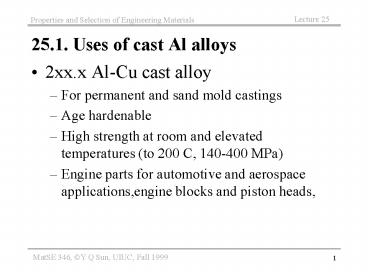25'1' Uses of cast Al alloys
1 / 19
Title: 25'1' Uses of cast Al alloys
1
25.1. Uses of cast Al alloys
- 2xx.x Al-Cu cast alloy
- For permanent and sand mold castings
- Age hardenable
- High strength at room and elevated temperatures
(to 200 C, 140-400 MPa) - Engine parts for automotive and aerospace
applications,engine blocks and piston heads,
2
- 3xx.x Al-Si-Cu cast alloy
- For permanent and sand mold castings
- High fluidity of molten metal
- Age hardenable
- High strength at room temperature (200-410 MPa)
- Low temperature engine parts for automotive and
aerospace applications, crank shaft, transmission
parts, alloy wheels
3
- 4xx.x Al-Si cast alloy
- Best fluidity of Al alloys
- Non age-hardenable
- Medium strength (120-170 MPa)
- Resistant to corrosion
- Casting intricate shapes.
4
25.2 Basic Al alloys
- Wrought alloy
- Hardenable medium ?y 2024 (Al-4.4Cu-0.6Mn-1.5Mg)
- Hardenable high ?y 7075 (Al-6Zn-2.5Mg-1.5Cu-0.5Fe
) - Non-hardenable 6061 (Al-0.6Si-0.3Cu-1Mg)
- Cast alloy
- Hardenable 204.0 (Al-4.6Cu-0.25Mg-0.35Mn)
- Non-hardenable 443.0 (Al-5Si)
5
25.3 Basic heat treatments of Al alloys
- T6 solution treat WQ AA
- T8 solution treat WQcold work AA
6
25.4 Corrosion resistance of Al alloys
- Unprotected Al is anodic to most metals.
- Protection by naturally formed dense oxide layer.
- Resistant to natural atmospheres, water and sea
water, soils and most foods. - Corrosion resistance is best for pure Al and
decreases with addition of alloying elements, esp
those that form precipitates
7
What will attack Al?
- Alkali (e.g. NaOH) water solutions, where Al2O3
is soluble. - Pitting and discoloring in sea water which
affects appearance but not durability.
8
Stress corrosion cracking
- SCC occurs in all grades of Al alloys
- Even in mild corrosion environments (e.g.
airplanes in marine condition). - Particular strong in age-hardened materials (2xxx
and 7xxx alloys)
9
25.5 Coatings of Al alloys
- Paint
- Anodizing treatment (anodized Al)
- Converting a thick surface layer into Al2O3.
- Oxidation by an electrochemical method in an
oxidizing acid (e.g. H2SO4). - The oxide layer provides both corrosion
protection and an abrasion-resistant surface. - Not protective in alkali solutions.
10
25.6Titanium alloys basic characteristics
- Resistance to corrosion, acids and bases
- Non-magnetic
- Low density (57 of Fe)
- High stiffness (57 of Fe)
- Pure Ti is biocompatible
- Low thermal expansion (70 of Fe)
- High melting temperature (1670 C)
- Resistance to fire
11
25.7 Types of Ti alloys
- Pure Ti ? (HCP) below 900 C
- ? (BCC) above 900 C
- Ti alloys
- ? or near ? alloys
- ? alloys or near ? alloys
- ?? two-phase (duplex) alloys
- No numerical designation
12
?? alloys (Pure Ti and alloys with Al, Ni, Sn)
- Low to medium yield strength (300-400 MPa)
- Ductile and tough (40 for pure Ti)
- Weldable
- Not age hardenable
- Not quench hardenable
- No brittle-ductile transition usable at low T
- Good resistance to creep useful at high T
13
?? alloys (with V, Nb, Cr, Fe, Mo)
- Medium to high strength (400-1100MPa)
- Ductile in fully annealed condition.
- Age hardenable
- Brittle-ductile transition brittle at low T.
- Resistance to creep poorer than ? alloys
14
?? alloys (Ti-6Al-4V, 50 all Ti alloys)
- Typically 50 ?, 50 ? actual fraction can be
altered with heat-treatment - Medium to high ?y (900-1150 MPa)
- Ductile in fully annealed condition
- Age hardenable.
- Quench hardenable.
- Limited ductility at low T (lt14 annealed)
- Poorer resistance to creep than ? alloys
15
- ? stabilizers
- V, Cr, Fe, Mo
- Enlarges the ? domain of the phase diagram
- Promote proportion of ? phase in the final
structure - Use to improve low temperature strength
16
Cr a ? stabilizer.
17
- Non-? stabilizers
- Al, Sn, Zr. Hf, Si
- Narrows or has no effect on the ? domain of the
phase diagram - Used to improve alloy properties without causing
? phase formation - Used to improve creep resistance of ? alloys.
- Used to improve oxidation resistance of ? and/or
? alloys
18
Al an ? enhancer
19
25.8 Uses of Ti alloys
- Corrosion resistance
- Mass efficient high strength (high ?y/?)
- No improvement in mass efficiency of
stiffness-limited application - Biocompatibility
- High temperature strength and fire resistance.































